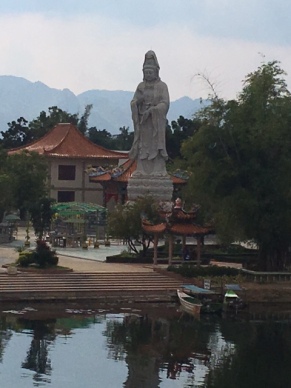After a few lovely days wandering Bangkok, it was time to explore the countryside of Thailand. We boarded the bus and drove out of town and into the suburban sprawl of modern civilization. Eventually we were out in the jungle and our first stop at an elephant camp where I fed the baby elephant and some of my fellow travelers took a ride through the jungle. Next on the agenda was some shopping at a floating market. Small narrow boats devoid of most safety precautions and with very sputtery engines sped us up the narrow canals to lunch and treasures for sale. I happily parted with my money for silk scarves for friends and a Buddha for my altar. After that we came to the River Kwai, made famous by the novel Bridge On The River Kwai about the labor camps during WWII. The movie of the same name won an Oscar for best picture in 1958. The river runs peacefully under a modern railroad bridge and past a very tall statue of Quan Yin. Some little girls entertained us with renditions of American tunes on their toy guitars, not quite ready for Nashville but charming none-the-less. That night we stayed in individual huts surrounded by the exotic jungle accessible only by narrow boats.
The next day Hamilton went off with the group to explore more WWII sites while I enjoyed the pool and jungle and watched the river go by. We left the next morning by boat along the river cliffs, the morning fog made our ride very beautiful and it really felt like a land far from home.
The next major stop was Ayutthaya, the former capital of Thailand from 1350-1767. It was eventually raided by the Burmese and the Thai government fled to what is now Bangkok. For hundreds of years the temples fell into the hands of time and nature until it became a World Heritage Site. It is this combination of former glories and decay than make it so beautiful to me.
That perfect day in Thailand we visited 3 temples. The first one, Wat Cahi Watthanaram, has a beautiful central prang or tower surrounded by 4 smaller towers. All along the walls were Buddhas, not the shinning gold ones of Bangkok, but Buddhas that had been ravished by time and vandals. Two beautiful Buddhas are on tall pedestals were whole and serene. I stood and breathed in the history and elegant architecture of this place that has stood for 400 years.
After lunch the next stop is probably the most famous of the Ayutthaya temples, Wat Mahathat, where there is the Buddha in a banyan tree. As nature took over the abandoned land, one serene image was entwined in nature and became even more beautiful. Even in neglect the peacefulness shines. I wandered around the site listening to chants on my ipod and admiring each Buddha in its own experience of decay. Some of the Buddhas were just feet or maybe even legs and a hand and occasionally a whole Buddha. But no matter what the current condition, each is honored.
The third temple on our visit was Wat Si Sanphet, considered the most important of the temples. Three restored stupas stand in the center and are the models for the later temples built in Bangkok. I walked around and admired each stupa individually and then as a group. The deep, blue sky was the perfect backdrop to these markers of sacred space. I was hot by the time we finished and I was happy to climb back on the cool bus to the hotel for the night. But each temple, and there were many more we missed, was a special experience, each with a distinct style and purpose but all the temples working in harmony to honor the enlightened path of Buddha.













Love reading these! Thanks Evans for sharing….